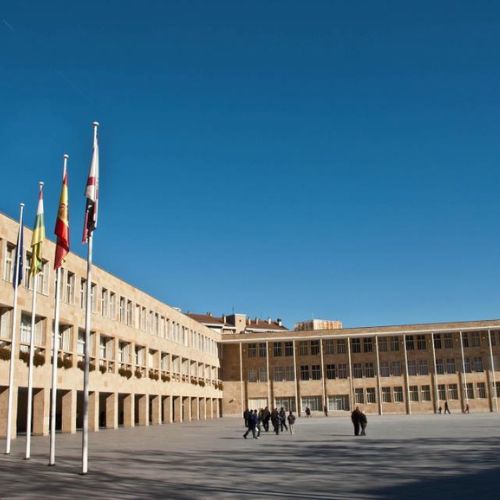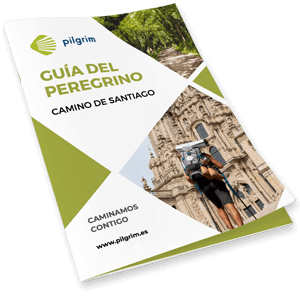Logroño
‹ Back to the stage
Logroño
- Residents: 151.962 aprox.
- Province: La Rioja
Information
Get to know Logroño
Once we leave Navarre we enter the lands of La Rioja and we find another great city, Logroño.
This is bathed by the Ebro River, the first major channel of the French Way and is considered as a crossroads since ancient times as it was the midpoint between the different kingdoms of the north of the peninsula.
Location
How to get there
Logroño is well connected thanks to the roads LO-20, A-12, A-11 and AP-68, only the last one has a toll area. If, on the other hand, you want to reach the city by public transport, there are several possibilities, plane, bus and train.
Logroño airport has hardly any air traffic but it has several flights to Madrid, another impediment is that despite being 9 km from the city has no public transport to get there.
<pWith regard to the other two transport options, both are very well connected with the main points of Spain such as: Madrid, Valencia, Leon, Alicante, Alicante, Zamora, Barcelona, Santander, Vigo, Pontevedra, Orense, Valladolid, A Coruña, etc.
History / Culture
What to see
Darien
Darien is a winery built in an avant-garde style by architect Jesús Mariano Pascual. It is surrounded by vineyards and is equipped with the most advanced technology for the production of personal and modern wines.
HOURS
From Monday to Saturday it is open from 11:00 to 17:00 Sundays from 11:00 to 14:00
Sundays from 11:00 to 14:00.
Fees
Guided tour with tasting of 1 wine: 6€ Guided tour with tasting of 4 wines and appetizer: 15€ Free visit with tasting of 1 wine: 3€
INFORMATION OF INTEREST
Web: www.darien.es E-mail: infor@darien.es Telephone: 941 25 81 30
Guided tours require reservations

Puente Mantible
The ruins of the Mantible bridge show one of the ancient routes to cross the Ebro. There is no agreement on the date of its construction; for historians it dates back to the first half of the second century, in the middle of the Roman imperial period, while for others, the bridge was built in the eleventh century and would be contemporary to the existing one in Puente la Reina.
Following the second theory, both bridges had been built to link the two main cities of the kingdom of Navarre, Pamplona and Nájera. Its length was 164 meters, with a width of 5 and with a maximum height of 30 meters. It was composed of seven semicircular arches, only two of which are still standing. In the structure, still visible today, you can see the excellent quality of the stonework used in its construction.

Museo Würth
Located in the El Sequero industrial estate, the Würth Museum, owned by the German multinational of the same name, is a contemporary art museum that usually combines prestigious exhibitions by renowned authors with museum collections belonging to the multinational’s own collections.

Puente de Piedra
The toll houses of the Stone Bridge were built at the end of the 19th century with the purpose of collecting taxes from people who wanted to access the city. Located opposite each other at each end of the bridge, they also served as housing for the carabineros who guarded the bridge.
Engineer Fermín Manso de Zúñiga erected this new infrastructure after his predecessor was demolished in 1871 due to a flood. This had twelve arches and exceeded two hundred meters in length. The reconstruction of the new bridge was completed in 1884, undergoing a new reform in 1917. It is one of the symbols of Logroño, being dated its appearance in the coat of arms of the city since 1285.

Teatro Bretón de Los Herreros
The Bretón de los Herreros Theater is the receiving space for large-format cultural shows. In addition, together with the Sala Amós Salvador, they are responsible for showing the city the avant-garde of art, through prestigious exhibitions for the quality of their works and the name of their authors.
This one is located in the center of Logroño, in the pedestrian street. It was financed through a popular subscription in which illustrious Riojans such as Espartero, Sagasta and the architect of the building himself, Felix Navarro, participated.

Calado de San Gregorio
The capital of La Rioja is known, above all, for its relationship with wine. Already in the sixteenth century it was customary to build cellars, which is the name given to the subway cellars in the area, under the floor of the houses of the city. At that time, families made their own wine for their own consumption. The “calados”, with ashlar walls, provide the ideal temperature and humidity for the fermentation and preservation of these wines.
The calado of San Gregorio, located in Ruavieja Street, is the longest of those that have survived to the present day. It is currently the heritage of the City Council, as it is a real jewel of traditional wine architecture. It is thirty meters long and its origins date back to the sixteenth century.

Castillo de Clavijo
The castle of Clavijo sits on a rocky promontory in the town of Clavijo, located about fifteen kilometers from Logroño.
According to Jacobean tradition, it was here that the apparition of the apostle St. James, mounted on his white steed, led the Christian troops to defeat the Muslim hordes in 844.

Centro de la Cultura de la Rioja
The Rioja Culture Center is the work of the architect Jesús Marino Pascual, located in the center of the city and in the historic center. The ambition of this project is to be an international reference for the culture of “Rioja” wine, in addition to fulfilling a function of rehabilitation of the social and cultural life of the historic city.
The center was built on the old palace of the Yangüas, from the sixteenth century, of which the entrance hall, the arch of the front, the stairwell, the fretwork, the roof and the balcony are still preserved. Its facade is presided over by the figure of a large bottle rack.

Cubo de Revellín y la Muralla
The Cubo de Revellín is a cubic structure fort that is preserved in perfect condition and houses inside a documentary exhibition on the history of the fortification of the city. Linked to this fort you can see two different sections of the wall.
The regrowth of the defensive masonry allows us to see what the northern facade of the city looked like in the 16th and 17th centuries, different periods in the construction of the defensive structure.

Edificio de Correos
The construction of the Post Office Building began in 1927, although it was inaugurated in 1932. It is a work of neo-baroque architecture signed by the architect Agapito del Valle, erected on the former convent of the Augustinian nuns.

Edificio del Parlamento
The Parliament Building of La Rioja is the former convent of La Merced, which has its origins in the fourteenth century, although almost all of it was built in the sixteenth century, as can be seen in the coats of arms of the order that adorn the north facade.
The convent, flanked by the wall, was located at one of the city gates. As time passed, the building has gone through all sorts of uses. In 1820 it served as a barracks; a decade later it was used as a military hospital, warehouse, artillery park and prison. Between 1847 and 1868 it was the home of the Carmelite nuns. That year, the building was exchanged for some plots of land and given to the City Council of Logroño, by means of a Royal Order. Due to the Carlist wars, the municipal ownership was lost and it passed into military hands.

Fuente del Peregrino
The fountain of the Pilgrim is located a few meters before reaching the ramp leading to the church of Santiago. The fountain is built in stone, it is composed of a recessed arch figure flanked by two pillars, frieze and pediment.
Although it is not known exactly the year of construction, what is known is data of a reconstruction that was carried out in 1675, although everything suggests that it is older. Since then its two spouts offer fresh water to pilgrims on their way to Santiago along the route of the French Way, where the fountain is located.

Iglesia de Santiago
The origins of the Church of St. James date back to 844 when Arcadius, a disciple of the Apostle, built the first church in honor of the saint.
That first temple was enlarged several times and destroyed by fire around 1500. The present church begins to be built immediately after the flames made the original one disappear.

Iglesia de San Bartolomé
The Church of San Bartolomé is the oldest of those preserved in the city. Erected in the early years of the thirteenth century, probably on an old church that already existed. Regarding its structure, it has a triple chevet, a transept, three naves and a tower. The chevet and the floor plan date back to the Romanesque style and, the closer we get to the main door, the more the Gothic style reigns. The reform that took place in the 16th century added new pillars, a covered vault and a choir at the entrance.

Imperial Iglesia de Santa María Palacio
The Church of Santa Maria del Palacio sits on an ancient church founded by the Order of the Holy Sepulchre and dates back to the second half of the 12th century.

Marqués de Murrieta
Marqués de Murrieta is a century-old project that dates back to 1852. A dream conceived by the Marqués de Murrieta, a native of Logroño and Riojan by adoption.
From 1983 to the present day the Cebrián-Sagarriga family, led by Vicente Dalmau Cebrián Sagarriga Count of Creixell, has been running the winery and its 300 hectares of surrounding vineyards.

Museo de La Rioja
Opened to the public in 1971, the Museum of La Rioja is located in the Palace of Espartero, with its main facade facing the Plaza de San Agustin. It is a Baroque-style building used by General Espartero after retiring from politics to live with his wife Jacinta Martínez de Sicilia.
It was built in the Baroque style by General Espartero after he retired from politics to live with his wife Jacinta Martínez de Sicilia.

Campo Viejo
El Campo Viejo was inaugurated in 2001 under the name of the new Campo Viejo winery. The reform of the winery was raised to find a balance between oenology and architecture with the aim of ensuring its sustainability over time. Thus was born this temple that is currently at the forefront of the international wine market.
Wines such as Campo Viejo, Alcorta, Azpilicueta are proof of this. First and only winery in Rioja with the Q for Quality Tourism Certification.

Palacio de Congresos
Also known by the nickname of Rioja Forum, the Palacio de Congresos de Logroño is the auditorium with the largest capacity in the city. Located in the enclave of the Parque de la Ribera, it was inaugurated in 2004 with a capacity of around three thousand people.
It has three floors where you can find among others an auditorium, a chamber hall, an exhibition hall or a banquet hall. It was conceived for holding large format shows and all kinds of events in terms of congresses or exhibitions.

Palacio Marqués de Monasterio
Located in the Herrerías area and current headquarters of the Social Security of Logroño, the Marqués de Monesterio Palace is a clear example of Renaissance architecture. It is in the sixteenth century when Francisco de Tejada and his wife Inés de Sesma carry out the construction of a house in the area of Herrerías where the current Palace has its origin, which would gain more weight when later an extension of the house to the Church of San Bartolomé was carried out by Juan de Tejada and his wife Leonor de Zúñiga.
It was already in the eighteenth century when the building was in the hands of the Marquises of Monesterio, the demolition of the last extension was carried out and the palace we know today was built. Throughout the nineteenth century there was a gradual decline of the house, which has been rehabilitated for the last time in the first decade of the twenty-first century.

Parque de La Grajera
The Grajera Park is an impressive site that spans more than four hundred hectares of land and whose hallmark is the reservoir built in the last third of the nineteenth century, on what was once only a small lake.

Plaza del Ayuntamiento
The Town Hall Square is surrounded by the building designed by the architect Rafael Moneo, in the years 1973-1974, concluding the works around 1980. It was built on the land occupied by an old barracks, this construction has perfectly fulfilled the objective of linking the old city with the new.
The square, of large dimensions and where the town hall building presides majestically with its sandstone facade, is as before a point of proactivity within the city.
Outstanding on the wall is the sculpture of the Lady of the Fountain, which stands on a fountain of the same name, made of bronze and with two water spouts that over time has become a true symbol of the City Hall.

Puente de Hierro
The Iron Bridge was inaugurated in 1882 and thanks to its construction the city improved its commercial connections with the north of Spain, especially with the Basque Country.
The idea came from the Riojan politician Práxedes Mateo Sagasta, who being president of the Government promoted the construction project of the same, being the work was designed by the engineer Fermín Manso de Zúñiga.

Bodega Ontañón
The Ontañón Winery-Museum was converted into a temple of wine culture thanks to the Riojan artist Miguel Ángel Sáinz.
The visit is threaded through the History of wine through mythology, culminating with the discovery of the treasure of the Ontañón Winery: the wine tasting.
TIME
Monday to Saturday open from 10:00 to 14:00 and from 16:00 to 19:00Sundays from 11:00 to 14:00
Sundays from 11:00 to 14:00.
INFORMATION OF INTEREST
Web: www.ontanon.esTeléfono: 941 234 200 / 690 85 85 19

Restos de la Antigua Vareia
The Remains of the Ancient Varela form an archaeological site of Roman origin. Most of these remains date from the V century although there are earlier, of them you can see the sections of the houses in which lived Titus Livius, Pliny, Strabo or Ptolemy and other illustrious figures of the Empire.

Casa de Mateo de Nuevas
The Casa de Mateo de Nuevas is the only architectural reference to the Inquisition in all of northern Spain, dating back to the 18th century.
The House of Mateo de Nuevas is the only architectural reference to the Inquisition in all of northern Spain.
In the interior of the temple, specifically in the dome, you can contemplate a mural painting depicting the coat of arms of the Inquisition. On the first floor, as in most of the houses in the Old Town, there is a place for winemaking.
The House of Mateo de Nuevas was built in the 18th century, thus being the only architectural reference to the Spanish Inquisition that exists in the north of Spain.

Concatedral de la Redonda
Of the Co-cathedral of La Redonda it is worth mentioning its façade with an oven structure, on the sides of which stand two 18th century towers known as “the twins”, in Baroque style.
The main entrance leads to the square and has a large stone altarpiece framed by Corinthian columns and protected by a gate that allows access to the chapel of Santo Cristo. Crowning the transept of the temple is an oven vault, in which we can appreciate the representations in relief of the four evangelists.

Sala Amós Salvador
The Amós Salvador Hall is one of the essential halls of contemporary culture in Logroño. It is located in one of the buildings that were part of the tobacco factory. The most famous works and artists of the moment, whether painters, sculptors, photographers or professionals of any other artistic discipline, pass through this room every year.

Bodega Marqués de Vargas
The Marqués de Vargas winery was built in 1989 and is located in the center of the Pradolagar estate. It is a winery with a rich history: as early as 1840, Don Felipe de la Mata, the eighth Marquis of Vargas, cultivated the first vineyards in their land, near Logroño.
Known as a “chateau”, the winery produces three high-end red wines: Marques de Vargas Reserva, M. Vargas Reserva Privada and Hacienda Pradolagar with selected grapes from its own vineyards of limited production.

Information of interest
Local police
941 235 011
Civil guard
941 221 100
Fire department
941 228 058
Civil protection
941 228 604
Town hall
941 277 000
Health center
941 261 414 / 941 509 310
Tourism office
941 277 000
C/ Portales, 50

We send you your itinerary
Enter your details and receive your travel itinerary by email
Recommended
Gastronomy
Recommended
Festivals and Pilgrimages
Local festivity
21 de septiembre: Fiesta de San Mateo
Local festivity
11 de junio: Fiesta de San Bernabé
French Way
On foot
33 stages



































